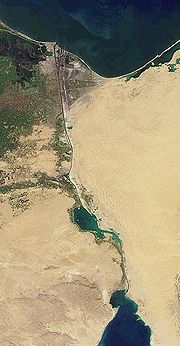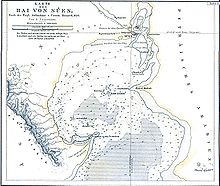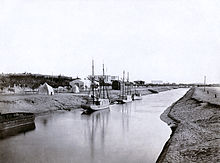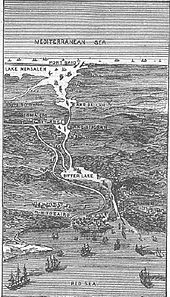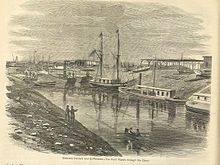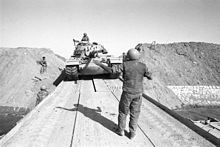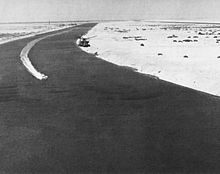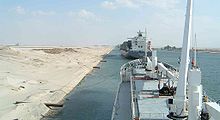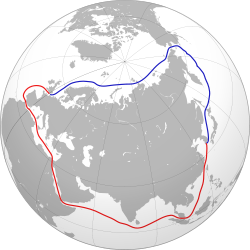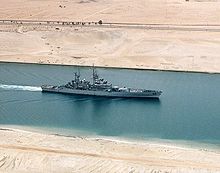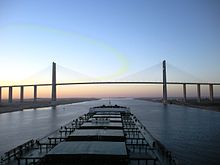- Suez Canal
-
Suez Canal Suez Canal, as seen from Earth orbit Original owner Suez Canal Company (Compagnie Universelle du Canal Maritime de Suez) Construction began April 1859 Date completed November 1869 Locks 0 Status Open Navigation authority Suez Canal Authority The Suez Canal (Arabic: قناة السويس Qanāt al-Sūwais), also known by the nickname "The Highway to India", is an artificial sea-level waterway in Egypt, connecting the Mediterranean Sea and the Red Sea. Opened in November 1869 after 10 years of construction work, it allows water transportation between Europe and Asia without navigation around Africa. The northern terminus is Port Said and the southern terminus is Port Tawfik at the city of Suez. Ismailia lies on its west bank, 3 km (1.9 mi) north of the half-way point.[1]
When first built, the canal was 164 km (102 mi) long and 8 m (26 ft) deep. After multiple enlargements, the canal is 193.30 km (120.11 mi) long, 24 m (79 ft) deep and 205 metres (673 ft) wide as of 2010.[2] It consists of the northern access channel of 22 km/14 mi, the canal itself of 162.25 km/100.82 mi and the southern access channel of 9 km/5.6 mi.[3]
The canal is single-lane with passing places in Ballah By-Pass and in the Great Bitter Lake.[4] It contains no locks; seawater flows freely through the canal. In general, the canal north of the Bitter Lakes flows north in winter and south in summer. The current south of the lakes changes with the tide at Suez.[5]
The canal is owned and maintained by the Suez Canal Authority[6] (SCA) of the Arab Republic of Egypt. Under international treaty, it may be used "in time of war as in time of peace, by every vessel of commerce or of war, without distinction of flag."[7]
Contents
History
Nile-Red Sea Canal(s)
Ancient west-east canals have facilitated travel from the Nile to the Red Sea.[8][9][10] One smaller canal is believed to have been constructed under the auspices of either Senusret II[11] or Ramesses II.[8][9][10] Another canal probably incorporating a portion of the first[8][9] was constructed under the reign of Necho II and completed by Darius.[8][9][10]
2nd millennium BC
The legendary Sesostris (likely either Pharaoh Senusret II or Senusret III of the Twelfth dynasty of Egypt[11][12]) is suggested to have perhaps started work on an ancient canal joining the River Nile with the Red Sea (1897 BC–1839 BC). (It is said that in ancient times the Red Sea reached northward to the Bitter Lakes[8][9] and Lake Timsah.[13][14])
In his Meteorology, Aristotle wrote:
One of their kings tried to make a canal to it (for it would have been of no little advantage to them for the whole region to have become navigatable; Sesostris is said to have been the first of the ancient kings to try), but he found that the sea was higher than the land. So he first, and Darius afterwards, stopped making the canal, lest the sea should mix with the river water and spoil it.[15]
Strabo also wrote that Sesostris started to build a canal, and Pliny the Elder wrote:
165. Next comes the Tyro tribe and, on the Red Sea, the harbour of the Daneoi, from which Sesostris, king of Egypt, intended to carry a ship-canal to where the Nile flows into what is known as the Delta; this is a distance of over 60 miles. Later the Persian king Darius had the same idea, and yet again Ptolemy II, who made a trench 100 feet wide, 30 feet deep and about 35 miles long, as far as the Bitter Lakes.[16]
French cartographers discovered the remnants of an ancient north-south canal running past the east side of Lake Timsah and ending near the north end of the Great Bitter Lake in the second half of the 19th century.[17] (This ancient, second, canal may have followed a course along the shoreline of the Red Sea when it once extended north to Lake Timsah.[14][17]) In the 20th century the northward extension of this ancient canal was discovered, extending from Lake Timsah to the Ballah Lakes,[18] which was subsequently dated to the Middle Kingdom of Egypt by extrapolating the dates of ancient sites erected along its course.[18] However it remains unknown whether or not this is the same as Sesostris' ancient canal and whether it was used as a waterway or as a defence against the east.
The reliefs of the Punt expedition under Hatshepsut 1470 BC depict seagoing vessels carrying the expeditionary force returning from Punt. This has given rise to the suggestion that, at the time, a navigable link existed between the Red Sea and the Nile.[19][20] Evidence seems to indicate its existence by the 13th century BC during the time of Ramesses II.[8][21][22][23]
Canals dug by Necho, Darius I and Ptolemy
Remnants of an ancient west-east canal, running through the ancient Egyptian cities of Bubastis, Pi-Ramesses, and Pithom were discovered by Napoleon Bonaparte and his cadre of engineers and cartographers in 1799.[9][24][25][26][27]
According to the Histories of the Greek historian Herodotus,[28] about 600 BC, Necho II undertook to dig a west-east canal through the Wadi Tumilat between Bubastis and Heroopolis,[9] and perhaps continued it to the Heroopolite Gulf and the Red Sea.[8] Regardless, Necho is reported as having never completed his project.[8][9]
Herodotus was told that 120,000 men perished in this undertaking, but this figure is doubtlessly exaggerated.[29] According to Pliny the Elder, Necho's extension to the canal was approximately 57 English miles,[9] equal to the total distance between Bubastis and the Great Bitter Lake, allowing for winding through valleys that it had to pass through.[9] The length that Herodotus tells us, of over 1000 stadia (i.e., over 114 miles), must be understood to include the entire distance between the Nile and the Red Sea[9] at that time.
With Necho's death, work was discontinued. Herodotus tells us that the reason the project was abandoned was because of a warning received from an oracle that others would benefit by its successful completion.[9][30] In fact, Necho's war with Nebuchadnezzar II most probably prevented the canal's continuation.
Necho's project was finally completed by Darius I of Persia, who conquered Ancient Egypt. We are told that by Darius's time a natural[9] waterway passage which had existed[8] between the Heroopolite Gulf and the Red Sea[31] in the vicinity of the Egyptian town of Shaluf[9] (alt. Chalouf[32] or Shaloof[14]), located just south of the Great Bitter Lake,[9][14] had become so blocked[8] with silt[9] that Darius needed to clear it out so as to allow navigation[9] once again. According to Herodotus, Darius's canal was wide enough that two triremes could pass each other with oars extended, and required four days to traverse. Darius commemorated his achievement with a number of granite stelae that he set up on the Nile bank, including one near Kabret, and a further one a few miles north of Suez. The Darius Inscriptions read:[33]
Saith King Darius: I am a Persian. Setting out from Persia, I conquered Egypt. I ordered this canal dug from the river called the Nile that flows in Egypt, to the sea that begins in Persia. When the canal had been dug as I ordered, ships went from Egypt through this canal to Persia, even as I intended.—Darius InscriptionThe canal left the Nile at Bubastis. An inscription on a pillar at Pithom records that in 270 or 269 BC it was again reopened, by Ptolemy II Philadelphus.[34] In Arsinoe,[9] Ptolemy constructed a navigable lock, with sluices, at the Heroopolite Gulf of the Red Sea[31] which allowed the passage of vessels but prevented salt water from the Red Sea from mingling with the fresh water in the canal.[9]
Receding Red Sea and the dwindling Nile
The Red Sea is believed by some historians to have gradually receded over the centuries, its coastline slowly moving farther and farther southward away from Lake Timsah[13][14] and the Great Bitter Lake[8][9] to its present coastline today. Coupled with persistent accumulations of Nile silt, maintenance and repair of Ptolemy's canal became increasingly cumbersome over each passing century.
Two hundred years after the construction of Ptolemy's canal, Cleopatra seems to have had no west-east waterway passage,[8][9] because the Pelusiac branch of the Nile River, which had fed Ptolemy's west-east canal, had by that time dwindled, being choked with silt.[8][9]
Old Cairo to the Red Sea
By the 8th century, a navigable canal existed between Old Cairo and the Red Sea,[8][9] but accounts vary as to who ordered its construction—either Trajan or 'Amr ibn al-'As, or Omar the Great.[8][9] This canal reportedly linked to the River Nile at Old Cairo[9] and ended near modern Suez.[8][35] A geography treatise by Dicuil reports a conversation with an English monk, Fidelis, who had sailed on the canal from the Nile to the Red Sea during a pilgrimage to the Holy Land in the first half of the 8th century [36]
The Abbasid Caliph al-Mansur is said to have ordered this canal closed in 767 to prevent supplies from reaching Arabian detractors.[8][9]
Repair by Tāriqu l-Ḥākim
Al-Hakim bi-Amr Allah is claimed to have repaired the Old Cairo to Red Sea passageway,[8][9] but only briefly, circa 1000 AD,[8][9] as it soon "became choked with sand."[9] However, we are told that parts of this canal still continued to fill in during the Nile's annual inundations.[8][9]
Napoleon discovers an ancient canal
Napoleon Bonaparte's interest in finding the remnants of an ancient waterway passage[37] culminated in a cadre of archaeologists, scientists, cartographers and engineers scouring the area beginning in the latter months of 1798.[38] Their findings, recorded in the Description de l'Égypte, include detailed maps that depict the discovery of an ancient canal extending northward from the Red Sea and then westward toward the Nile.[37][39]
Napoleon had contemplated the construction of another, modern, north-south canal to join the Mediterranean and Red Sea. But his project was abandoned after the preliminary survey erroneously concluded that the Red Sea was 10 metres (33 ft) higher than the Mediterranean, making a locks-based canal too expensive and very long to construct. The Napoleonic survey commission's error came from fragmented readings mostly done during wartime, which resulted in imprecise calculations.[40] Though by this time unnavigable,[9] the ancient route from Bubastis to the Red Sea still channeled water in spots as late as 1861[9] and as far east as Kassassin.
Mediterranean-Red Sea Canal
Interim period
Although the alleged difference in sea levels could be problematic for a canal's construction, the idea of finding a shorter route to the east remained alive. In 1830, F. R. Chesney submitted a report to the British government, which stated that there was no difference in altitude, and that the Suez Canal was feasible, but his report received no further attention. Lieutenant Waghorn established his Overland Route, which transported post and passengers to India via Egypt. Linant de Bellefonds, a French explorer of Egypt, became chief engineer of Egypt's Public Works. In addition to his normal duties, he surveyed the Isthmus of Suez and made plans for the Suez Canal. French Saint-Simonianists showed an interest in the canal and in 1833, Barthélemy Prosper Enfantin tried to draw Muhammad Ali's attention to the canal but was unsuccessful. Alois Negrelli, the Austrian railroad pioneer, became interested in the idea in 1836. In 1846, Prosper Enfantin's Société d'Études du Canal de Suez invited a number of experts, among them Robert Stephenson, Negrelli and Paul-Adrien Bourdaloue to study the feasibility of the Suez Canal (with the assistance of Linant de Bellefonds). Bourdaloue's survey of the isthmus was the first generally accepted evidence that there was no practical difference in altitude between the two seas. Britain, however, feared that a canal open to everyone might interfere with its India trade and, therefore, preferred a connection by train from Alexandria via Cairo to Suez, which eventually was built by Stephenson.
Construction by Suez Canal Company
In 1854 and 1856 Ferdinand de Lesseps obtained a concession from Sa'id Pasha, the Khedive of Egypt and Sudan, to create a company to construct a canal open to ships of all nations. The company was to operate the canal for 99 years from its opening. De Lesseps had used his friendly relationship with Sa'id, which he had developed while he was a French diplomat during the 1830s. As stipulated in the concessions, de Lesseps convened the International Commission for the piercing of the isthmus of Suez (Commission Internationale pour le percement de l'isthme des Suez) consisting of thirteen experts from seven countries, among them McClean, President of the Institution of Civil Engineers in London, and again Negrelli, to examine the plans of Linant de Bellefonds and to advise on the feasibility of and on the best route for the canal. After surveys and analyses in Egypt and discussions in Paris on various aspects of the canal, where many of Negrelli's ideas prevailed, the commission produced a final unanimous report in December 1856 containing a detailed description of the canal complete with plans and profiles.[41] The Suez Canal Company (Compagnie Universelle du Canal Maritime de Suez) came into being on 15 December 1858 and work started on the shore of the future Port Said on 25 April 1859.
The excavation took some 10 years using forced labour (corvée) of Egyptian workers during a certain period. Some sources estimate that over 30,000 people were working on the canal at any given period, that altogether more than 1.5 million people from various countries were employed, and that thousands of laborers died on the project.[42][43]
The British government had opposed the project of the canal from the outset to its completion. As one of the diplomatic moves against the canal, it disapproved the use of slave labor of forced workers on the canal. The British Empire was the major global naval force and officially condemned the forced work and sent armed Bedouins to start a revolt among workers. Involuntary labour on the project ceased, and the viceroy condemned the corvée, halting the project.[44]
Angered by the British opportunism, de Lesseps sent a letter to the British government remarking on the British lack of remorse a few years earlier when forced workers died in similar conditions building the British railway in Egypt.
Initially international opinion was skeptical and Suez Canal Company shares did not sell well overseas. Britain, the United States, Austria, and Russia did not buy any significant number of shares.[45] All French shares were quickly sold in France. A contemporary British sceptic claimed:
“ One thing is sure... our local merchant community doesn't pay practical attention at all to this grand work, and it is legitimate to doubt that the canal's receipts... could ever be sufficient to recover its maintenance fee. It will never become a large ship's accessible way in any case. (reported by German historian Uwe A. Oster) ” 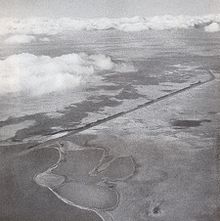 Suez Canal in February 1934. Air photograph taken by Swiss pilot and photographer Walter Mittelholzer.
Suez Canal in February 1934. Air photograph taken by Swiss pilot and photographer Walter Mittelholzer.
The canal opened to shipping on 17 November 1869. Although numerous technical, political, and financial problems had been overcome, the final cost was more than double the original estimate.[46] The opening was performed by Khedive Ismail of Egypt and Sudan, and at Ismail's invitation French Empress Eugenie in the Imperial yacht Aigle, piloted by Napolean Coste who was bestowed by the Khedive the Order of the Medjidie (Blue Flame of Service c1955). The first ship to follow the yacht Aigle through the canal was the British P&O liner Delta.[47]
After the opening of the canal, the Suez Canal Company was in financial difficulties. The remaining works were completed only in 1871, and traffic was below expectations in the first two years. De Lesseps therefore tried to increase revenues by interpreting the kind of net ton referred to in the second concession (tonneau de capacité) as meaning a ship's real freight capacity and not only the theoretical net tonnage of the Moorsom System introduced in Britain by the Merchant Shipping Act in 1854. The ensuing commercial and diplomatic activities resulted in the International Commission of Constantinople establishing a specific kind of net tonnage and settling the question of tariffs in their protocol of 18 December 1873.[48] This was the origin of the Suez Canal Net Tonnage and the Suez Canal Special Tonnage Certificate still used today.
The canal had an immediate and dramatic effect on world trade. Combined with the American transcontinental railroad completed six months earlier, it allowed the entire world to be circled in record time. It played an important role in increasing European colonisation of Africa. The construction of the Suez Canal was one of the reasons of the Panic of 1873, because the goods from the Far East were carried in sailing vessels around the Cape of Good Hope and were stored in British warehouses, but sailing vessels were not adaptable for use through the Suez Canal, because the prevailing winds of the Mediterranean Sea blow from west to east.[49] External debts forced Said Pasha's successor, Isma'il Pasha, to sell his country's share in the canal for £4,000,000 to the United Kingdom in 1875, but French shareholders still held the majority. Prime Minister Benjamin Disraeli was accused by William Ewart Gladstone of undermining Britain's constitutional system, due to his lack of reference or consent from Parliament when purchasing the shares with funding from the Rothschilds.[50]
The Convention of Constantinople in 1888 declared the canal a neutral zone under the protection of the British, who had occupied Egypt and Sudan at the request of Khedive Tewfiq to suppress the Urabi Revolt against his rule. They were later to defend the strategically important passage against a major Ottoman attack in 1915, during the First World War.[51] Under the Anglo-Egyptian Treaty of 1936, the United Kingdom insisted on retaining control over the canal. In 1951 Egypt repudiated the treaty, and in 1954 the UK agreed to remove its troops. Withdrawal was completed on 18 July 1956.
Suez Crisis
After the United Kingdom and the United States withdrew their pledge to support the construction of the Aswan Dam due to Egyptian overtures towards the Soviet Union, Egyptian President Gamal Abdel Nasser nationalized the canal in 1956 and transferred it to the Suez Canal Authority, intending to finance the dam project using revenue from the canal. This led up to the Suez Crisis, known in the Arab World as the 'Tripartite Aggression', in which the UK, France and Israel invaded Egypt. According to the pre-agreed war plans under the Protocol of Sèvres, the Israelis invaded Egypt's Sinai Peninsula, forcing Egypt to engage them militarily, and allowing the Anglo-French partnership to declare the resultant fighting a threat to the canal and enter the war on Israel's side.
To save the British from what he thought was a disastrous action, and to stop the war from a possible escalation, Canadian Secretary of State for External Affairs, Lester B. Pearson, proposed the creation of the first United Nations peacekeeping force to ensure access to the canal for all, and an Israeli withdrawal from the Sinai. On 4 November 1956, a majority of nations at the United Nations voted for Pearson's peacekeeping resolution, which mandated the UN peacekeepers to stay in Sinai unless both Egypt and Israel agreed to their withdrawal. The United States backed this proposal by putting pressure on the British government by selling sterling, which would cause it to depreciate. Britain then agreed to withdraw its troops. Pearson was later awarded the Nobel Peace Prize. As a result of damage and ships intentionally sunk under orders from Nasser[52] the canal was closed until April 1957, when it was cleared with UN assistance. A UN force (UNEF) was established to maintain the free navigability of the canal, and peace in the Sinai Peninsula.
Arab-Israeli wars of 1967 and 1973
In May 1967 President Nasser ordered the UN peacekeeping forces out of Sinai, including the Suez Canal area. Israel objected to the closing of the Straits of Tiran to Israeli shipping. The canal itself had been closed to Israeli shipping since 1949, except for a short period in 1951–1952.
After the 1967 Arab-Israeli war, called the Six Day War, the canal was closed by an Egyptian blockade until 5 June 1975. As a result, fourteen cargo ships known as "The Yellow Fleet" remained trapped in the canal for over eight years. In 1973, during the Yom Kippur War, the canal was the scene of a major crossing by the Egyptian army into Israeli-occupied Sinai, and in the later stage of the war, a crossing by the Israeli army to African Egypt. Much wreckage from this conflict remains visible along the canal's edges.[citation needed]
In reaction to the Yom Kippur War the United States initiated Operation Nimbus Moon. The helicopter carrier USS Iwo Jima (LPH-2) was sent to the Canal, carrying twelve RH-53D minesweeping helicopters of HM-12. These partly cleared the Suez Canal between May and December 1974. She was relieved by the LST USS Barnstable County (LST1197). The British Royal Navy initiated ( Operation Rheostat) and Task Group 65.2 provided the RN Minehunters, HMS Maxton, HMS Bossington & HMS Wilton and HMS Abdiel a Practice Minelayer / MCMV Support Ship which spent two periods of 6 months in 1974 and in 1975 based at Ismailia. When the Canal Clearance Operations were completed, the Suez Canal and its lakes were considered 99% clear of mines. The Canal was then reopened by President Sadat aboard an Egyptian destroyer which led the first convoy Northbound to Port Said in 1975.[53]
The UNEF mandate expired in 1979. Despite the efforts of the United States, Israel, Egypt, and others to obtain an extension of the UN role in observing the peace between Israel and Egypt, as called for under the Egypt-Israel Peace Treaty of 1979, the mandate could not be extended because of the veto by the USSR in the security council, at the request of Syria. Accordingly, negotiations for a new observer force in the Sinai produced the Multinational Force and Observers (MFO), stationed in Sinai in 1981 in coordination with a phased Israeli withdrawal. It is there under agreements between the United States, Israel, Egypt, and other nations.[54]
Capacity
The canal allows passage of ships up to 20 m (66 ft) draft or 240,000 deadweight tons and up to a maximum height of 68 m (223 ft) above water level and a maximum beam of 77.5 m (254 ft) under certain conditions.[55][56]
Some supertankers are too large to traverse the canal. Others can offload part of their cargo onto a canal-owned boat to reduce their draft, transit, and reload at the other end of the canal.
Alternatives
The main alternative is travelling around the Cape of Good Hope at the south of the African continent. This was the only route before the canal was constructed, and—more recently—when the canal was closed. It is still the only route for ships which are too large for the canal. In the early 21st century the long route has enjoyed increased popularity because of increasing piracy in Somalia.[57][58] Between 2008 and 2010, it is estimated that the canal has lost 10% of traffic due to the threat of piracy, and another 10% due to the financial crisis. An oil tanker going from Saudi Arabia to the United States has 2,700 miles longer to go when taking the route south of Africa rather than the canal.[59]
Before the canal's opening in 1869 goods were sometimes offloaded from ships and carried overland between the Mediterranean and the Red Sea.[60]
In recent years, the shrinking Arctic sea ice has also made the Northern Sea Route viable for commercial cargo ships plying between Europe and East Asia during a six-to-eight week window in the summer months, shaving off thousands of miles from the voyage compared to the Suez Canal. According to polar climate researchers, as the extent of the Arctic summer ice pack recedes, the route will become passable without the help of icebreakers for a greater period each summer.[61][62][63]
The Bremen-based Beluga Group claimed in 2009 to be the first Western company to attempt crossing the Northern Sea Route for shipping without assistance from icebreakers, cutting 4000 nautical miles off the journey between Ulsan, Korea and Rotterdam, the Netherlands.[64]
Operation
The canal has no locks due to the flat terrain, and the minor sea level difference between each end is inconsequential for shipping.
There is one shipping lane with passing areas in Ballah-Bypass near El Qantara and in the Great Bitter Lake. On a typical day, three convoys transit the canal, two southbound and one northbound. The first southbound convoy enters the canal in the early morning hours and proceeds to the Great Bitter Lake, where the ships anchor out of the fairway, awaiting passage of the northbound convoy. The northbound convoy passes the second southbound convoy, which moors in Ballah-Bypass. The passage takes between 11 and 16 hours at a speed of around 8 knots (15 km/h; 9 mph). The low speed helps prevent erosion of the canal banks by ships' wakes.
By 1955 approximately two-thirds of Europe's oil passed through the canal. About 7.5% of world sea trade is carried via the canal today. In 2008, a total of 21,415 vessels passed through the canal and the receipts from the canal totaled $5.381 billion,[55] with the average cost per-ship at roughly $251,000.
New Rules of Navigation that constitute an improvement over the older ones were passed by the board of directors of the Suez Canal Authority (SCA) to organise vessels’ and tankers’ transit that came into force as of 1 January 2008.
The most important amendments to the Rules include allowing vessels with 62-foot (19 m) draught to transit and increasing the allowed breadth from 32 metres (105 ft) up to 40 metres (130 ft) following improvement operations, as well as imposing a fine on vessels using divers without permission from outside the SCA inside the canal boundaries.
The amendments also allow vessels loaded with dangerous cargo, such as radioactive or inflammable materials, to transit, if they conform with the latest amendments provided by international conventions.
The SCA also has the right to determine the number of tugs required to assist warships transiting the canal to achieve the highest degree of safety during transit.[65]
The Suez Canal can handle more ship traffic and larger ships than the Panama Canal.
Connections between the shores
From north to south, the connections are:
- The Suez Canal Bridge (30°49′42″N 32°19′03″E / 30.828248°N 32.317572°E), also called the Egyptian-Japanese Friendship Bridge, is a high-level road bridge at El Qantara. In Arabic, al qantara means "the bridge". It has a 70-metre (230 ft) clearance over the canal and was built with assistance from the Japanese government and by PentaOcean Construction.
- El Ferdan Railway Bridge (30°39′25″N 32°20′02″E / 30.657°N 32.334°E) 20 km (12 mi) north of Ismailia (30°35′N 32°16′E / 30.583°N 32.267°E) was completed in 2001 and is the longest swing span bridge in the world, with a span of 340 m (1100 ft). The previous bridge was destroyed in 1967 during the Arab-Israeli conflict.
- Pipelines taking fresh water under the canal to Sinai, about 57 km (35 mi) north of Suez, at 30°27.3′N 32°21.0′E / 30.455°N 32.35°E.
- Ahmed Hamdi Tunnel (30°5′9″N 32°34′32″E / 30.08583°N 32.57556°E) south of the Great Bitter Lake (30°20′N 32°23′E / 30.333°N 32.383°E) was built in 1983. Because of leakage problems, a new water-tight tunnel [66] was built inside the old one, from 1992 to 1995.
- The Suez Canal overhead line crossing (29°59′46″N 32°34′59″E / 29.996°N 32.583°E) powerline was built in 1999.
A railway on the west bank runs parallel to the canal for its entire length.
Environmental impact
The opening of the Suez Canal in 1869 created the first salt-water passage between the Mediterranean and Red seas. Although the Red Sea is about 1.2 m (4 ft) higher than the eastern Mediterranean,[67] the current between the Mediterranean and the middle of the canal at the Bitter Lakes flows north in winter and south in summer. The current south of the Bitter Lakes is tidal, varying with the height of tide at Suez.[5] The Bitter Lakes, which were hypersaline natural lakes, blocked the migration of Red Sea species into the Mediterranean for many decades, but as the salinity of the lakes gradually equalised with that of the Red Sea, the barrier to migration was removed, and plants and animals from the Red Sea have begun to colonise the eastern Mediterranean. The Red Sea is generally saltier and more nutrient-poor than the Atlantic, so the Red Sea species have advantages over Atlantic species in the salty and nutrient-poor eastern Mediterranean. Accordingly, most Red Sea species invade the Mediterranean biota, and only few do the opposite. This migratory phenomenon is called Lessepsian migration (after Ferdinand de Lesseps) or Erythrean invasion. Also impacting the eastern Mediterranean, starting in 1968, was the operation of Aswan High Dam across the River Nile. While providing for increased human development, the project both reduced the inflow of freshwater and ended all natural nutrient-rich silt from entering the eastern Mediterranean at the adjacent Nile Delta. This provided less natural dilution of Mediterranean salinity and ended the higher levels of natural turbidity, additionally making conditions more like those in the Red Sea.[citation needed]
Invasive species originated from the Red Sea and introduced into the Mediterranean by the construction of the canal have become a major component of the Mediterranean ecosystem, and have serious impacts on the Mediterranean ecology, endangering many local and endemic Mediterranean species. Currently about 300 species from the Red Sea have been identified in the Mediterranean Sea, and there are probably others yet unidentified. The Egyptian government's intent to enlarge the canal has raised concerns from marine biologists, fearing that this will worsen the invasion of Red Sea species in the Mediterranean.[68]
Construction of the Suez Canal was preceded by cutting a small fresh-water canal from the Nile delta along Wadi Tumilat to the future canal, with a southern branch to Suez and a northern branch to Port Said. Completed in 1863, these brought fresh water to a previously arid area, initially for canal construction, and subsequently facilitating growth of agriculture and settlements along the canal.[69]
Timeline
- Circa 1799 — Napoleon Bonaparte conquers Egypt and orders a feasibility analysis. This reports a supposed 10-metre (33 ft) difference in sea levels and a high cost, so the project is put on hold.
- Circa 1840 — A second survey finds the first analysis incorrect. A direct link between the Mediterranean Sea and the Red Sea is possible and not as expensive as previously estimated.
- 30 November 1854 — The former French consul in Cairo, Ferdinand Marie de Lesseps, obtains the first license for construction and subsequent operation from the Viceroy for a period of 99 years.
- 6 January 1856 — Lesseps is provided with a second, more detailed license.
- 15 December 1858 — Lesseps establishes the "Compagnie Universelle du Canal Maritime de Suez", with Said Pasha acquiring 22% of the Suez Canal Company; the majority is still controlled by French private holders.
- 25 April 1859 — The Suez Canal construction officially starts.
- 16 November 1869 — The Suez Canal is opened, being owned and operated by Suez Canal Company.
- 18 December 1873 — The International Commission of Constantinople establishes the Suez Canal Net Ton and the Suez Canal Special Tonnage Certificate (as known today)
- 25 November 1875 — Britain becomes a minority share holder in the Suez Company, acquiring 44% of the Suez Canal Company, with the remainder being controlled by French business syndicates.
- 20 May 1882 — Britain invades Egypt, with French assistance, and begins its occupation of Egypt.
- 25 August 1882 — Britain takes control of the canal.
- 2 March 1888 — The Convention of Constantinople renews the guaranteed right of passage of all ships through the Suez Canal during war and peace; these rights were already part of the licenses awarded to Lesseps, but are recognized as international law.
- 14 November 1936 — Following a new treaty, Britain theoretically pulls out of Egypt, but establishes the 'Suez Canal Zone', under its control.
- 13 June 1956 — Suez Canal Zone is restored to Egyptian sovereignty, following final British withdrawal and years of negotiations.
- 26 July 1956 — Egypt nationalizes the Suez Canal Company; all its Egyptian assets, rights and obligations are transferred to the Suez Canal Authority, which compensates the previous owners at the established pre-nationalization price.
- 31 October 1956 to 24 April 1957 — Suez Canal is blocked to shipping following the planned invasion of the eastern Sinai by Israel, and later French and British, occupation of the Suez Canal Zone.
- 22 December 1956 — The canal zone is restored to Egyptian control, following French and British withdrawal, and the landing of UNEF troops.
- 5 June 1967 to 10 June 1975 — Suez Canal is blocked by Egypt, following a war with Israel; it becomes the front line during the ensuing War of Attrition and the 1973 war, remaining closed to international shipping, until general agreement was near.
- 1 January 2008 — New rules of navigation passed on by the Suez Canal Authority come into force.
Leadership (1858–present)
Presidents of the Suez Canal Company (1858–1956)
Before nationalisation:
- Ferdinand de Lesseps (15 December 1858 – 7 December 1894)
- Jules Guichard (17 December 1892 – 17 July 1896) (acting for de Lesseps to 7 December 1894)
- Auguste-Louis-Albéric, prince d'Arenberg (3 August 1896–1913)
- Charles Jonnart (19 May 1913–1927)
- Louis de Vogüé (4 April 1927 – 1 March 1948)
- François Charles-Roux (4 April 1948 – 26 July 1956)
Chairmen of the Suez Canal Authority (1956–present)
Since nationalisation:
- Doctor Mohamed Helmy Bahgat Badawy (26 July 1956 – 9 July 1957)
- Engineer Mahmoud Younis (10 July 1957 – 10 October 1965)
- Engineer Mashhour Ahmed Mashhour (14 October 1965 – 31 December 1983)
- Engineer Mohamed Ezzat Adel (1 January 1984 – December 1995)
- Admiral Ahmed Ali Fadel (22 January 1996 – present)
Popular culture
- Suez, a film made in 1938, starred Tyrone Power as de Lesseps and Loretta Young as a love interest. An epic, it is very loosely based on history.
- The Suez Canal appears in the 1962 film Lawrence of Arabia, where it marks the end of T. E. Lawrence's march across the Sinai Peninsula to report to his superiors in Cairo.
- The Suez Crisis is mentioned in the 1989 hit song "We Didn't Start the Fire" by Billy Joel.
- Michael Palin visited the Suez Canal in 1988 as part of his TV adventure series, Around the World in 80 Days.
- The Suez Canal is also a map in the game Battlefield 2142.
- The idea of the Suez Canal is mentioned in the Asterix comic book series, Asterix and Cleopatra by René Goscinny and Albert Uderzo. It was first published in serial form in Pilote magazine, issues 215–257, in 1963. On page 47, Asterix offers the future assistance of the Gaulish people should Egypt consider a passage linking the Red Sea and the Mediterranean. This offer is taken up 1,900 years later.
- In Jules Verne's novel 20,000 Leagues Under the Sea, the Nautilus travels through an underwater passage beneath the Suez Canal.
- On an episode of the TV series Glee, Sue Sylvester (Jane Lynch) claims she was a sniper and an aid to the storming of the Suez Canal.
- Sailors that are aboard a U.S. Navy ship while it transits the full length of the Suez canal are deemed part of the "Safari to Suez" fraternity.
See also
- Panama Canal
- Pharaoh (historical novel by Bolesław Prus, incorporating motifs of an ancient Suez Canal)
References
- ^ "Suez Canal guide". Marine Services Co. http://www.atlas.com.eg/scg.html. Retrieved 2 April 2010.
- ^ "Canal Characteristics". Suez Canal Authority. 2010. http://www.suezcanal.gov.eg/sc.aspx?show=12. Retrieved 2 April 2010.
- ^ "Characteristics of the canal". http://www.sis.gov.eg/En/Land&people/SCanal/031300000000000002.htm.
- ^ Suez Canal Authority
- ^ a b The Red Sea Pilot. Imray Laurie Norie & Wilson. 1995. p. 266.
- ^ Official "Web Site of the Suez Canal Authority". http://www.suezcanal.gov.eg Official.
- ^ Constantinople Convention of the Suez Canal of 2 March 1888 still in force and specifically maintained in Nasser's Nationalisation Act.
- ^ a b c d e f g h i j k l m n o p q r s t Encyclopaedia Britannica, 11th edition, s.v. "Suez Canal". Accessed 8 August 2008.
- ^ a b c d e f g h i j k l m n o p q r s t u v w x y z aa ab ac ad ae af Rappoport, S. (Doctor of Philosophy, Basel). History of Egypt (undated, early 20th century), Volume 12, Part B, Chapter V: "The Waterways of Egypt," pages 248-257. London: The Grolier Society.
- ^ a b c Hassan, F. A. & Tassie, G. J. Site location andhistory (2003). Kafr Hassan Dawood On-Line, Egyptian Cultural Heritage Organization. Accessed 8 August 2008.
- ^ a b Please refer to Sesostris#Modern research.
- ^ J. H. Breasted attributes the ancient canal's early construction to Senusret III, up through the first cataract. Please refer to J. H. Breasted, Ancient Records of Egypt, Part One, Chicago 1906, §§642-648
- ^ a b The Columbia Encyclopedia, Sixth Edition, s.v. "Suez Canal". Accessed 14 May 2008.
- ^ "'''Meteorology''' (1.15)". Ebooks.adelaide.edu.au. 25 August 2010. http://ebooks.adelaide.edu.au/a/aristotle/meteorology/book1.html. Retrieved 24 August 2011.
- ^ The Elder Pliny and John Healey Natural History (6.33.165) Penguin Classics; Reprint edition (5 Feb 2004) ISBN 978-0-14-044413-1 p.70 [1]
- ^ a b Carte hydrographique de l'Basse Egypte et d'une partie de l'Isthme de Suez (1855, 1882). Volume 87, page 803. Paris. See [2].
- ^ a b Shea, William H. "A Date for the Recently Discovered Eastern Canal of Egypt," in Bulletin of the American Schools of Oriental Research, No. 226 (April 1977), pp. 31–38.
- ^ Sanford (1938), p.72; Garrison (1999), p.36.
- ^ Recent excavations in Wadi Gawasis appear to indicate that Egypt's maritime trade started from ports on the Red Sea and did not require a canal.
- ^ Hess, Richard S. Rev. of Israel in Egypt: The Evidence for the Authenticity of the Exodus Tradition, by James K. Hoffmeier. The Denver Journal 1 (1 January 1998). Accessed 14 May 2008.
- ^ Hassan, Fekri A. Kafr Hassan Dawood On-line, 17 August 2003. Accessed 14 May 2008.
- ^ (Spanish) Martínez Babon, Javier. "Consideraciones sobre la Marinay la Guerra durante el Egipto Faraónico". Accessed 14 May 2008.
- ^ Descriptions de l'Égypte, Volume 11 (État Moderne), containing Mémoire sur la communication de la mer des Indes à la Méditerranée par la mer Rouge et l'Isthme de Sueys, par M. J.M. Le Père, ingénieur en chef, inspecteur divisionnaire au corps impérial des ponts et chaussées, membre de l'Institut d'Égypte, pp. 21–186
- ^ Their reports were published in Description de l'Égypte
- ^ Montet, Pierre. Everyday Life In The Days Of Ramesses The Great (1981), page 184. Philadelphia: University of Pennsylvania Press.
- ^ Silver, Morris. Ancient Economies II (6 Apr. 1998), "5c. Evidence for Earlier Canals." ANCIENT ECONOMIES II, retrieved 8 Aug. 2008. Economics Department, City College of New York.
- ^ Herodotus ii.158.
- ^ "The figure ‘120,000’ is doubtless exaggerated. Mehemet Ali lost only 10,000 in making the Mahmûdieh Canal (from the Nile to Alexandria)." remarked W. W. How and J. Wells, A Commentary on Herodotus.
- ^ According to Herodotus, work on the project was "stayed by a prophetic utterance that he [Necho] was toiling beforehand for the barbarian. The Egyptians call all men of other languages barbarians." (Herodotus, eo. loc..)
- ^ a b . Apparently, Ptolemy considered the Great Bitter Lake as a northern extension of the Red Sea, whereas Darius had not, because Arsinoe is located north of Shaluf. (See Naville, "Map of the Wadi Tumilat," referenced above.)
- ^ Please refer to Darius the Great's Suez Inscriptions.
- ^ Jona Lendering. "Darius' Suez Inscriptions". Livius.org. http://www.livius.org/aa-ac/achaemenians/DZ.html. Retrieved 24 August 2011.
- ^ F. W. Walbank, The Hellenistic World 1981:202. Ptolemy II Philadelphus's lifespan was 309 BC–246 BC.
- ^ Petermann, A. Karte Der Bai Von Súes (1856). Nach der Engl. Aufnahme v. Comm. Mansell.
- ^ Tuchman, Barbara Bible and Sword: How the British came to Palestine MacMillan, London (1987) ISBN 0 333 33414 0
- ^ a b Linda Hall Library, Kansas City, Missouri. The Search for the Ancient Suez Canal, accessed 20 August 2008. [3]
- ^ Please refer to Description de l'Égypte.
- ^ Descriptions de l'Égypte, Volume 11 (État Moderne), containing Mémoire sur la communication de la mer des Indes à la Méditerranée par la mer Rouge et l'Isthme de Sueys, par M. J.M. Le Père, ingénieur en chef, inspecteur divisionnaire au corps impérial des ponts et chaussées, membre de l'Institut d'Égypte, pp. 21–186
- ^ Wilson, The Suez Canal
- ^ Percement de l'isthme de Suez. Rapport et Projet de la Commission Internationale. Documents Publiés par M. Ferdinand de Lesseps. Troisième série. Paris aux bureaux de l'Isthme de Suez, Journal de l'Union des deux Mers, et chez Henri Plon, Éditeur, 1856. On Google Books (french)
- ^ Arnold. T. Wilson, The Suez Canal
- ^ "Le canal de Suez – ARTE". Arte.tv. 13 August 2006. http://www.arte.tv/fr/connaissance-decouverte/aventure-humaine/Cette_20semaine/1291022.html. Retrieved 24 August 2011.
- ^ Oster (2006)
- ^ There are differing informations on the exact amounts
- ^ *Bent Flyvbjerg, Nils Bruzelius, and Werner Rothengatter, Megaprojects and Risk: An Anatomy of Ambition (Cambridge University Press, 2003). ISBN 0-521-00946-4
- ^ "The Suez Canal". Russojapanesewar.com. http://www.russojapanesewar.com/lewis-5.html. Retrieved 24 August 2011.
- ^ Protocol of the Commission (in french)
- ^ The economic development of the American nation, p. 356, Reginald Charles McGrane, Ginn & Co., Boston 1950.
- ^ Stephen J. Lee, Gladstone and Disraeli. Routledge, 107
- ^ First World War - Willmott, H.P. Dorling Kindersley, 2003, Page 87
- ^ The Other Side of Suez (documentary) – 2003
- ^ http://www.history.navy.mil/nan/backissues/1970s/1974/sep74.pdf
- ^ (Multinational Force and Observers)
- ^ a b Suez Canal Authority http://www.suezcanal.gov.eg
- ^ "Canal Characteristics". Suez Canal Authority. 2010. http://www.suezcanal.gov.eg/sc.aspx?show=12. Retrieved 14 April 2010.
- ^ Economic Impact of Piracy Hits Home – The New American
- ^ Arab countries meet to tackle Somali pirate threat – CSMonitor.com
- ^ Bowden, Anna et al. The Economic Cost of Maritime Piracy page 13. One Earth Future, December 2010. Accessed: 26 February 2011.
- ^ Overland Mail by Thomas Fletcher Waghorn, Railway Alexandria – Cairo – Suez built by Robert Stephenson
- ^ "The Final Frontier: The Northern Sea Route". http://www.husdal.com/2011/05/22/the-final-frontier-the-northern-sea-route.
- ^ "Bye pirates, hello Northeast Passage". AsianCorrespondent.com. 3 January 2010. http://asiancorrespondent.com/39881/bye-bye-pirates-hello-north-east-passage. Retrieved 29 May 2011.
- ^ "Melting ice cap opens up Northeast Passage to British ships". Mail Online. 12 September 2009. http://www.dailymail.co.uk/news/worldnews/article-1213025/Melting-ice-cap-opens-Northeast-Passage-British-ships.html. Retrieved 29 May 2011.
- ^ "German vessels ready for the Northern Sea Route". BarentsObserver.com. 5 August 2009. http://www.barentsobserver.com/german-vessels-ready-for-the-northern-sea-route.4616626-16175.html. Retrieved 21 September 2009.
- ^ SC News
- ^ "Salt-Corroded Tunnel Undergoes Major Renovation". Kajima.co.jp. http://www.kajima.co.jp/topics/perspect/vol_15_3/salt/. Retrieved 24 August 2011.
- ^ Madl, Pierre (1999). Essay about the phenomenon of Lessepsian Migration, Colloquial Meeting of Marine Biology I, Salzburg, April 1999 (revised in Nov. 2001).
- ^ Galil and Zenetos (2002)
- ^ Britannica (2007)
Sources
- Britannica (2007) "Suez Canal", in: The new Encyclopædia Britannica, 15th ed., 28, Chicago, Ill. ; London : Encyclopædia Britannica, ISBN 1-59339-292-3
- Galil, B.S. and Zenetos, A. (2002). "A sea change: exotics in the eastern Mediterranean Sea", in: Leppäkoski, E., Gollasch, S. and Olenin, S. (eds), Invasive aquatic species of Europe : distribution, impacts, and management, Dordrecht ; Boston : Kluwer Academic, ISBN 1-4020-0837-6, p. 325–336
- Garrison, Ervan G. (1999) A history of engineering and technology : artful methods, 2nd ed., Boca Raton, Fla. ; London : CRC Press, ISBN 0-8493-9810-X
- Oster, Uwe (2006) Le fabuleux destin des inventions : le canal de Suez, TV documentary produced by ZDF and directed by Axel Engstfeld (Germany)
- Sanford, Eva Matthews (1938) The Mediterranean world in ancient times, Ronald series in history, New York : The Ronald Press Company, 618 p.
External links
- The suez canal official government website
- Darius the Great's Suez Inscriptions
- Constantinople Convention of the Suez Canal, 1888
- Encyclopedia of the Orient: Suez Canal
- Entrance of the Suez Canal – 1882
- Plan of the Suez Canal – 1882
- Suez Canal Container Terminal at Port Said
- Suez Canal Photos
- Opening of the Suez Canal, 1869
- Bibliography on Water Resources and International Law Peace Palace Library
- Suez Canal article on Howstuffworks
Coordinates: 30°42′18″N 32°20′39″E / 30.705°N 32.34417°E
Suez Canal History 
Current authorities Infrastructure WaterworksCitiesConstructionsMarine life Categories:- Suez Canal
- Macro-engineering
- Egypt–United Kingdom relations
- Buildings and structures completed in 1869
- Ship canals
- Economy of Egypt
- Canals in Egypt
- Geography of Egypt
- Water transport in Egypt
- Red Sea
- Cuts (earthmoving)
Wikimedia Foundation. 2010.

